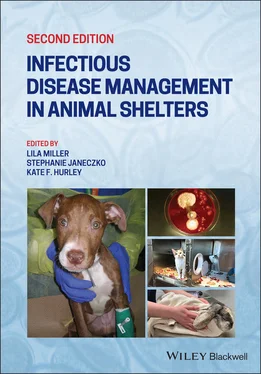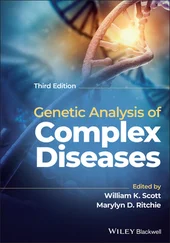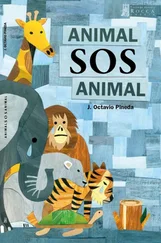At the same time, the potential rewards of successful disease management in shelters are even greater than the challenges. Infectious disease in shelters has historically been a leading cause for euthanasia. But, in addition to being literally lifesaving, successfully treating individual animals, managing outbreaks, and most especially, preventing disease increases animals’ welfare. Prevention of illness can also conserve precious resources and free up space in the shelter that would otherwise be occupied by sick animals. In turn, the improved public confidence that a healthy population tends to generate can lead to greater support of the shelter, higher adoption rates, and an increased capacity to invest in programs to decrease shelter admission and keep pets healthy and safe with their families.
1.1.1 Fundamentals of Disease Control in Shelters
Though some unique considerations exist for shelters, the fundamentals of disease management rest on a familiar foundation. In veterinary medicine, it is customary to think about the “disease triad” that describes the interaction of pathogen, host and environment in determining whether disease occurs. Introduction of pathogens into a shelter is virtually inevitable; therefore, efforts focus on supporting animals' immunity and limiting disease spread within the environment.
This text will provide strategies to accomplish each of these goals with respect to specific pathogens commonly encountered in shelters, as well as general information on methods to support immunity and limit environmental spread (e.g. see Chapter 2on Wellness, Chapter 9on Canine and Feline Vaccinations and Immunology, Chapter 8on Sanitation and Chapter 6on Outbreak Management). The reader will find information that reflects the ways in which shelter‐specific considerations result in recommendations that vary from the approach that might be recommended in another context.
For instance, maternally derived antibodies (MDA) in juvenile animals have both good and bad consequences: they provide initial protection against disease but also potentially block vaccines. Initial levels of MDA will determine the age at which vaccines can overcome this interference, and this information has historically guided vaccine recommendations for pet puppies and kittens born to vaccinated dams. However, it is now known that many juvenile animals entering shelters were either born to unvaccinated dams and therefore received no MDA (and therefore no potential for MDA interference); or were born to mothers who survived field strain infection and may have transmitted high levels of MDA (Lechner et al. 2010). This means vaccines may be effective either earlier or later in comparison to offspring of a vaccinated dam with an intermediate level of MDA to transmit. This, coupled with the higher disease exposure risk common to shelters, leads to the recommendation to start vaccination earlier and continue longer for puppies and kittens in a shelter environment.
Another example can be found in the treatment recommendations for dermatophytosis. Often a self‐limiting disease of little consequence in privately owned pets, this zoonotic and environmentally persistent (and resistant) pathogen has historically been the cause of euthanasia in many shelters. However, protocols that limit environmental contamination through effective topical, as well as systemic treatment, have been developed to allow this condition to be managed successfully at an increasing number of shelters (Newbury et al. 2011).
1.1.2 The Production Medicine Model
For all its benefits, infectious disease control is only one goal of a successful shelter medical program. The production medicine model, developed in the context of commercial animal husbandry enterprises, proves surprisingly applicable here. The successful livestock veterinarian understands their role extends beyond treatment or even prevention of disease. Rather, they provide guidance to help the production system reach a variety of goals, which may include such things as providing a healthy, safe food product, ensuring that the enterprise is financially sustainable, providing good welfare and maintaining compliance with relevant regulations. None of these goals may be reached at the expense of another.
Similarly, the shelter practitioner must approach the task of disease control with an understanding of the mission of the organization, its goals, requirements and priorities. The true art of shelter medicine involves balancing risks to best serve overall objectives, especially those that are potentially in conflict with one another. Balancing isolation and confinement for infectious disease control with allowing exercise, social interaction and contact with adopters is just one example.
The recommendations in this text aim to highlight some of the ways in which risk and reward balance in a shelter vary in comparison to other contexts. Methods are suggested to mitigate risks while maximizing the shelter's ability to meet their goals. Paradoxically, veterinarians can sometimes best contribute to overall shelter success by recommending practices that are seemingly less cautious rather than more when it comes to infectious disease control. For instance, routine quarantine of healthy‐appearing incoming animals is commonly recommended in herd‐health contexts to screen for animals that may be incubating disease. However, the increased length of stay (LOS) this practice entails, along with the increased population density as well as the cost and staff burden that results, often undermine other goals of the shelter such as judicious use of limited resources and rapid movement of healthy animals into adoptive homes. Alternative strategies to limit disease introduction, without the need for quarantine, include accurate history taking when possible, the performance of careful intake exams and vaccination, daily rounds and monitoring, optimized sanitation procedures and appropriate and prompt use of diagnostic testing. These topics are covered in more detail in Chapter 2on Wellness and elsewhere in this text.
1.1.3 What's New in the Second Edition?
As with any subject, the understanding of infectious disease management has evolved in the decade since the publication of the first edition. Ongoing research has refined the profession's knowledge of complex and emerging diseases such as feline leukemia and canine influenza, leading to updated recommendations for diagnostic testing and management in shelter animals. Practical field experience has also honed understanding of the best ways to manage long‐standing problems. For instance, at the time of publication of the first text, the use of antibody titers and RT‐PCR (reverse transcription‐ polymerase chain reaction) testing for the management of canine distemper outbreaks was relatively new. These methods have now been proven effective in managing many shelter outbreaks, leading to expanded opportunities for non‐lethal responses to this potentially devastating illness.
Alongside these advances in understanding disease management, new products have also led to expanded opportunities to preserve shelter animal health. For instance, accelerated hydrogen peroxide (Rescue™) has become a widely used disinfectant in shelters over the last 10 years. This product's reliability against viruses, safety, rapid action, multiple uses and relatively good penetration into organic matter have allowed more efficient sanitation strategies as well as more flexible use of housing materials. Another example is the development of “portals” to conjoin two cages into one more spacious double‐compartment unit, allowing segregation of eating and resting areas from those used for elimination. The reduced handling and disease transmission associated with double‐compartment housing, along with reduced stress, have led to reported reductions in feline upper respiratory infections (URI) of 70% or more at some shelters (CFHS 2018; Karsten et al. 2017).
Читать дальше












